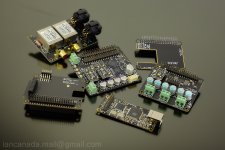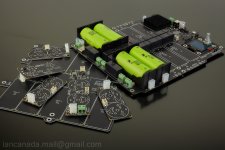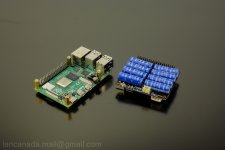Really looking forward to this. When are these (including the DAC HATs) likely to be available? Is the volume control driver available? Any comparison with the audiophonic ES9038Q2M i-sabre? I believe the latter has a driver for the on board ESS volume control.
is there any plugin to connect to Raspberry Pi 4 B/B+?
is there any plugin to connect to Raspberry Pi 4 B/B+?
I'm using Pi 4 with Ian's FIFO and dual mono DAC, no problems.
Using Mo0de audio player moodeaudio.org.
Last edited:
I'm using Pi 4 with Ian's FIFO and dual mono DAC, no problems.
Using Mo0de audio player moodeaudio.org.
oh great!!!!, are you using any AMP and what OS are you using? playback soft?
thank you so much!
ES9038Q2MPi Dual Mono Plus DAC HAT
It has been upgraded to ES9038Q2MPi Dual Mono Plus recently.
New improvements are:
1. Three separated power rails for AVCC, DVCC and VCCA.
2. Optimized PCB layout with 2oz double thickness copper layers for lowest possible noise level.
3. Make it just focus on sound quality by removing all unrelated circuits from PCB.
4. Enhanced ultra low ESR decoupling networks for better voltage rails quality.
5. New swappable XO socket design make it possible to upgraded to better local clock.
6. Very easy to switch to SYNC modem by just removing local XO from the socket and plugging a u.fl MCLK cable. Thus the SYNC mode will have less noise and no longer need the jumper switches.
7. Ready to work with 3.3V ultra capacitor power supplies.

9038Q2MpiDmPlusa by Ian, on Flickr
Ian
It has been upgraded to ES9038Q2MPi Dual Mono Plus recently.
New improvements are:
1. Three separated power rails for AVCC, DVCC and VCCA.
2. Optimized PCB layout with 2oz double thickness copper layers for lowest possible noise level.
3. Make it just focus on sound quality by removing all unrelated circuits from PCB.
4. Enhanced ultra low ESR decoupling networks for better voltage rails quality.
5. New swappable XO socket design make it possible to upgraded to better local clock.
6. Very easy to switch to SYNC modem by just removing local XO from the socket and plugging a u.fl MCLK cable. Thus the SYNC mode will have less noise and no longer need the jumper switches.
7. Ready to work with 3.3V ultra capacitor power supplies.

9038Q2MpiDmPlusa by Ian, on Flickr
Ian
It has been upgraded to ES9038Q2MPi Dual Mono Plus recently.
New improvements are:
1. Three separated power rails for AVCC, DVCC and VCCA.
2. Optimized PCB layout with 2oz double thickness copper layers for lowest possible noise level.
3. Make it just focus on sound quality by removing all unrelated circuits from PCB.
4. Enhanced ultra low ESR decoupling networks for better voltage rails quality.
5. New swappable XO socket design make it possible to upgraded to better local clock.
6. Very easy to switch to SYNC modem by just removing local XO from the socket and plugging a u.fl MCLK cable. Thus the SYNC mode will have less noise and no longer need the jumper switches.
7. Ready to work with 3.3V ultra capacitor power supplies.

9038Q2MpiDmPlusa by Ian, on Flickr
Ian
Hi Ian,
it looks very nice.
I just read the doc and can't understand something:
<< Further gains can be made by stopping the DPLL and enabling True Sync mode. BUT there are limitations to True
Sync mode with the ES9038Q2M:
- It supports PCM format only. DSD and DoP are not supported.
- MCLK has to be 128FSR >>
I'm actually using the v1 of this board with a diyinhk XMOS 768kHz DXD DSD512 in true sync with dpll off and I listen music at DSD512.
Why is there this PCM limitation on the new board?
Or maybe I don't understand something?
@terry22
New 9038Q2MPi Dual Mono Pluse doesn't change register settings. should be the same.
I found that the true sync mode does support DSD, but at certain frequencies related to MCLK. Can you confirm that the with 45.xxxMHz true sync works good for DSD512?
On my system, true sync supports PCM at all frequencies. It sounds greater than any other settings. I can not live without this mode.
Regards,
Ian
New 9038Q2MPi Dual Mono Pluse doesn't change register settings. should be the same.
I found that the true sync mode does support DSD, but at certain frequencies related to MCLK. Can you confirm that the with 45.xxxMHz true sync works good for DSD512?
On my system, true sync supports PCM at all frequencies. It sounds greater than any other settings. I can not live without this mode.
Regards,
Ian
Ian what's you preferred clock these days?
Pulsar, CCHD957, AS318-B ....
Pulsar is the best of the best
Ian
Yesterday I offered my streamer into my brothers system with Vitus Audio class a integrated amplifier. Using balanced cables it sounded dreadful. Lots of distortion. Ess controller at 0db. Eventually fathomed that lowering the volume on the controller to 30db helped and started to sound how it should. Sounds fine with SE RCA cables.
So this is something to do with the voltage being too high with the balanced output.? Can someone explain a lite and offer best solution.? Are all XLR outputs not necessarily compatible with all amps?
Thanks
So this is something to do with the voltage being too high with the balanced output.? Can someone explain a lite and offer best solution.? Are all XLR outputs not necessarily compatible with all amps?
Thanks
Which input did you use on Vitus amp? Streamers usually put out line level signals (roughly on the order of one volt RMS at full output), a mic level or phono level input would expect much lower voltages.
Also, how are you producing the balanced output signals, with transformers or with I/V stages?
Also, how are you producing the balanced output signals, with transformers or with I/V stages?
...Would a passive transformer output stage produce less voltage output than the active opamp stage?
I haven't used the transformer output option rather than I/V, maybe someone else can answer about any level differences.
With the I/V stage however, proper unbalancing of the signals is important for minimizing common mode distortion from the dac outputs. Some balanced inputs only match impedances on both inputs, but are not true differential. That might be something else to check on. Real differential will produce an output at the amplifier there is only at signal at pin 2 or only a signal at pin 3. Pseudo differential only produces an output using one of the pins.
Also, to minimize distortion you might find it best to turn down the dac volume until no distortion, then turn down the volume at the computer starting from full up, then slowly down to as low as -6dBFS or -8dBFS to find the point where distortion is minimized from that. You will need to turn up the dac volume as you turn down the computer volume to keep the output volume the same. You are only looking to minimize audible distortion.
Last, if you are using Windows you should know how to configure Windows sound engine not to resample your audio stream (Windows can and will automatically resample audio device streams it knows about by default unless care is taken to prevent it; unfortunately, there is a sound quality penalty when it does). If you don't know how, then please ask so someone can go through it with you.
Last edited:
@terry22
New 9038Q2MPi Dual Mono Pluse doesn't change register settings. should be the same.
I found that the true sync mode does support DSD, but at certain frequencies related to MCLK. Can you confirm that the with 45.xxxMHz true sync works good for DSD512?
Hi Ian,
I'm using 90/98MHz accusillion clocks.
But if I remember well, it was working too with 45Mhz CCHD957.
Is the dac card already available?
BTW, why didn't you separate AVCC-L and AVCC-R?
I'll try this. thank you for the advice.On my system, true sync supports PCM at all frequencies. It sounds greater than any other settings. I can not live without this mode.
Best regards,
terry
Using BridgePi to setup an USB based RPi DAC project
With BridgePi, making an USB streamer based RPi DAC is possible.
This DAC can be connected either to a RPi or to a Mini PC, would be more flexible. And USB streamers support native DSD rather than DoP so also be more interesting to play with.
I'm gonna start a new DAC project with this idea.
DAC section:
1. BridgePi
2. FifoPi Q2
3. ShieldPi
4. 9038Q2M Dual Mono Plus
5. Transform I/V
6. ESS controller
7. USB streamer (XMOS or Amanero)
Power supply section:
1. LifePO4 Mk III
2. UcMateConditioner
2. UcHybrid
3. UcAdapter
Player section:
1. Raspberry Pi4
2. ConditionerPi
or Just a mimi PC
Ian
With BridgePi, making an USB streamer based RPi DAC is possible.
This DAC can be connected either to a RPi or to a Mini PC, would be more flexible. And USB streamers support native DSD rather than DoP so also be more interesting to play with.
I'm gonna start a new DAC project with this idea.
DAC section:
1. BridgePi
2. FifoPi Q2
3. ShieldPi
4. 9038Q2M Dual Mono Plus
5. Transform I/V
6. ESS controller
7. USB streamer (XMOS or Amanero)
Power supply section:
1. LifePO4 Mk III
2. UcMateConditioner
2. UcHybrid
3. UcAdapter
Player section:
1. Raspberry Pi4
2. ConditionerPi
or Just a mimi PC
Ian
Attachments
Last edited:
Ian, your post (whilst I acknowledge is a simple hasty typo... we all do this  ) caught my attention for it's description of 'not a Pi PC'
) caught my attention for it's description of 'not a Pi PC' 
The bolded has quite an apt,perhaps ?, meaning in our native tongue...
mimi - Māori Dictionary
I'm gonna start a new DAC project with this idea.
DAC section:
1. BridgePi
2. FifoPi Q2
3. ShieldPi
4. 9038Q2M Dual Mono Plus
5. Transform I/V
6. ESS controller
7. USB streamer (XMOS or Amanero)
Power supply section:
1. LifePO4 Mk III
2. UcMateConditioner
2. UcHybrid
3. UcAdapter
Player section:
1. Raspberry Pi4
2. ConditionerPi
or Just a mimi PC
Ian
The bolded has quite an apt,perhaps ?, meaning in our native tongue...
mimi - Māori Dictionary
Last edited:
- Home
- Source & Line
- PC Based
- ES9018K2M, ES9028Q2M, 9038Q2M DSD/I2S DAC HATs for Raspberry Pi


